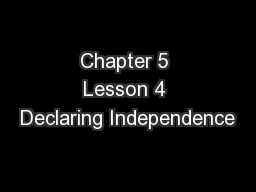

Essential Question What motivates people to act Learning Goal Students will be able to compare points of view held by Patriots and Loyalists evaluate the reaction of the colonies to the rejection of the Olive Branch Petition summarize the steps taken that led to the writing of the Declarati ID: 683052
Download Presentation The PPT/PDF document "Chapter 5 Lesson 4 Declaring Independenc..." is the property of its rightful owner. Permission is granted to download and print the materials on this web site for personal, non-commercial use only, and to display it on your personal computer provided you do not modify the materials and that you retain all copyright notices contained in the materials. By downloading content from our website, you accept the terms of this agreement.
Slide1
Chapter 5Lesson 4
Declaring IndependenceSlide2
Essential Question:
What motivates people to act?
Learning Goal:Students will be able to compare points of view held by Patriots and Loyalists, evaluate the reaction of the colonies to the rejection of the Olive Branch Petition, summarize the steps taken that led to the writing of the Declaration of Independence, and understand the four parts of the Declaration of Independence.
Essential Question & Learning GoalSlide3
May 10, 1775
John Adams, Samuel Adams, Patrick Henry, George Washington, Thomas Jefferson, and Benjamin Franklin are all present
John Hancock is chosen at the president of the CongressThe Second Continental CongressSlide4
Congress decisions:
Print own money,
Communicate with Indians for better relationship
Create Continental Army
Washington
is General
Set up a
Post OfficeWrite Olive Branch PetitionOffer of peace and independence from Great Britain by the colonists.
Key ActionsSlide5
In response to the Olive Branch Petition
King George III sends 12,000
German troops to the coloniesCalled Hessians- mercenary soldiers
Key ActionsSlide6
Patriots learned British in Canada planned to invade
New York.
Americans strike first- capture MontrealAmericans failed to capture Quebec- Led by Benedict Arnold
The War Heats UpSlide7
July 1775
British hold
Boston but Patriot militias are still outside the cityWashington realizes his men are disorganized and lacked discipline
March 1776- After some training
Washington believes his men are ready to fight and moves them at night to attack
British
in Boston
The War Heats UpSlide8
British realize they are going to be attacked
And leave Boston
March 17, 1776Washington leads his troops into Boston to find the British troops had sailed away.
The War Heats UpSlide9
Some colonists wanted to stay with Great Britain but more and more wanted independence.
Thomas Paine encouraged colonists to support independence.
Author of Common SenseTold the colonists toUnited against the British
It is common sense to be a Patriot and independent
Moving Toward IndependenceSlide10
Second
Continental Congress
Debated whether the colonies should remain with Britain or declare independenceA committee of colonists wrote the Declaration while the Congress still debatedJohn Adams, Benjamin Franklin, Thomas Jefferson, Robert Livingston, and Roger Sherman were on the committee
Jefferson
wrote the first draft
Used ideas from John Locke
Writing the DeclarationSlide11
Jefferson explained why the colonies were declaring freedom
Ideas of
life
,
liberty
,
property
; governments exist to protect the rights of the peopleFour Parts
I: Preamble- I
ntroR: Declaration of Natural RightsC
: List of Grievances (complaints)D: Declaration of a new nation- the states now had the power to
wage warWriting the DeclarationSlide12
VIDEOSlide13
July 2, 1776
Second Continental Congress voted to become
independent12/13 colonies votedNew York did not vote but later announced support
July 4, 1776
The Declaration was approved with a few changes
John Hancock
signed first
56 people signedCopies were printed and sent to coloniesWriting the Declaration